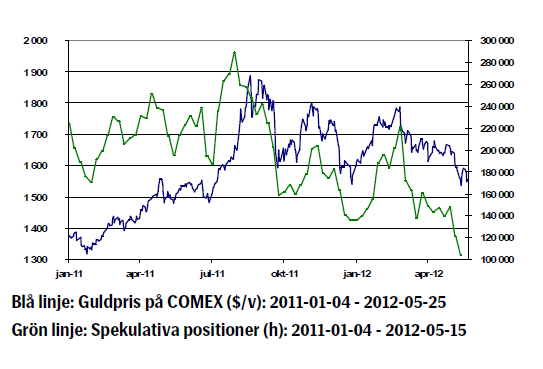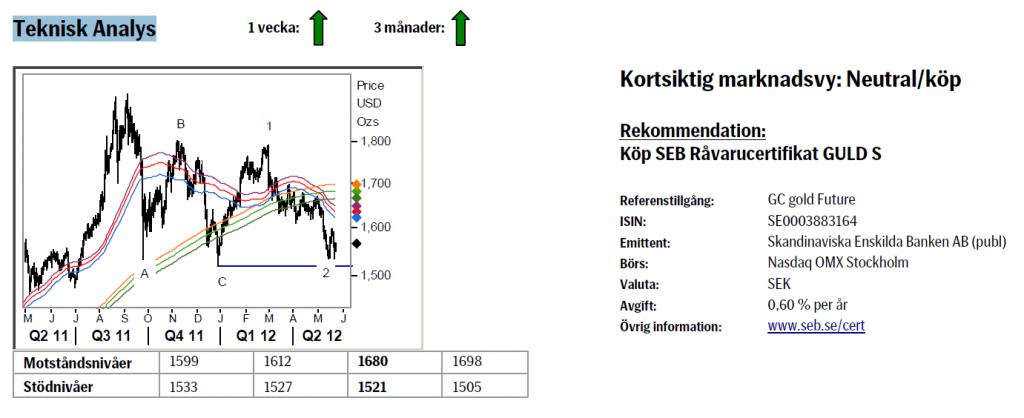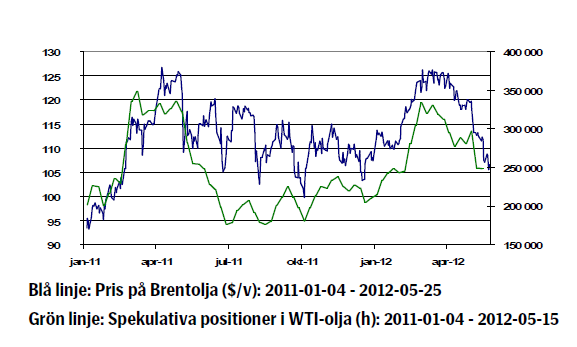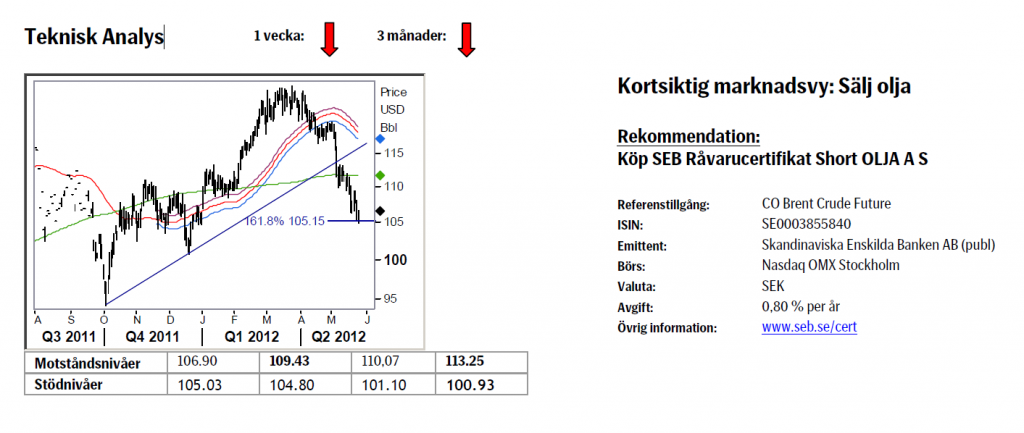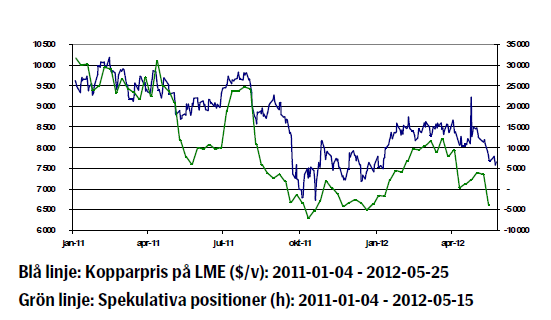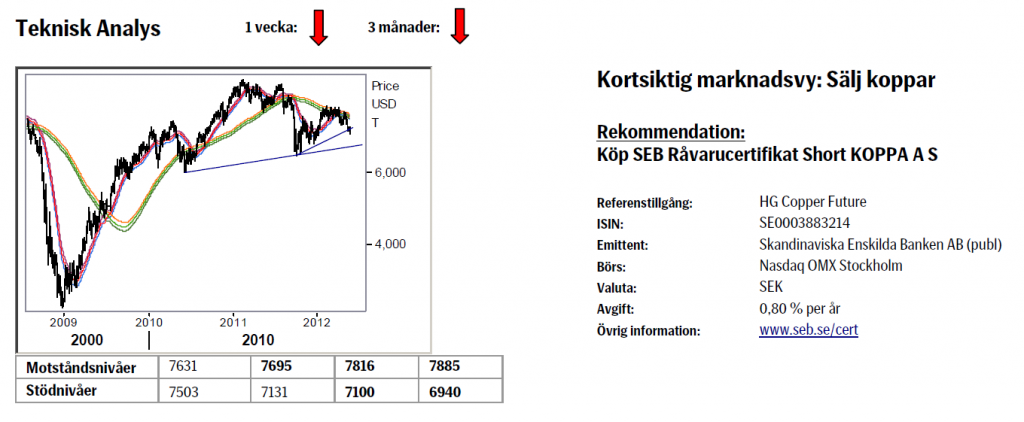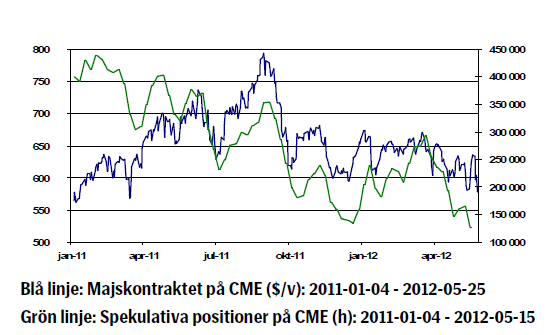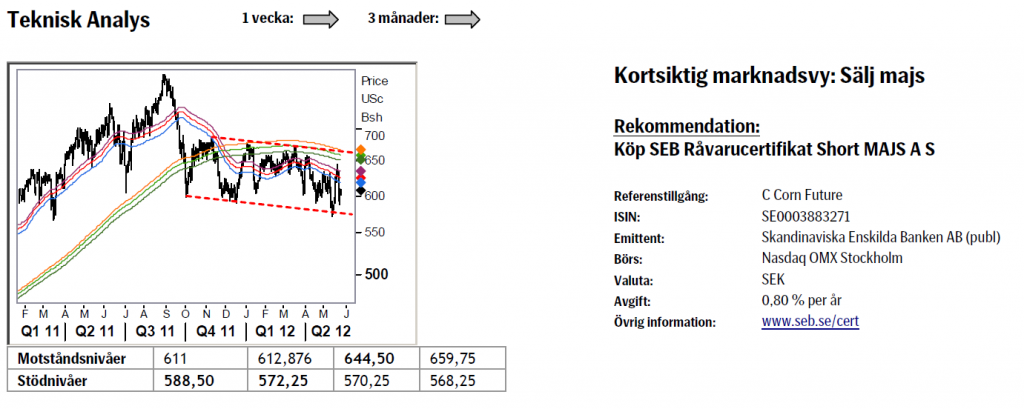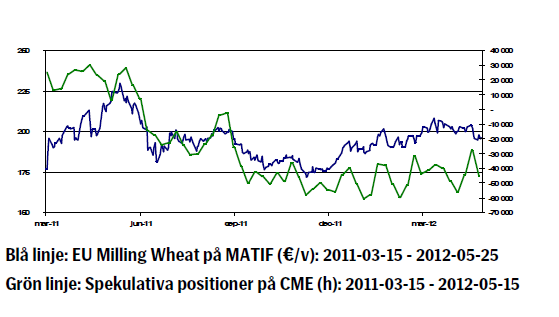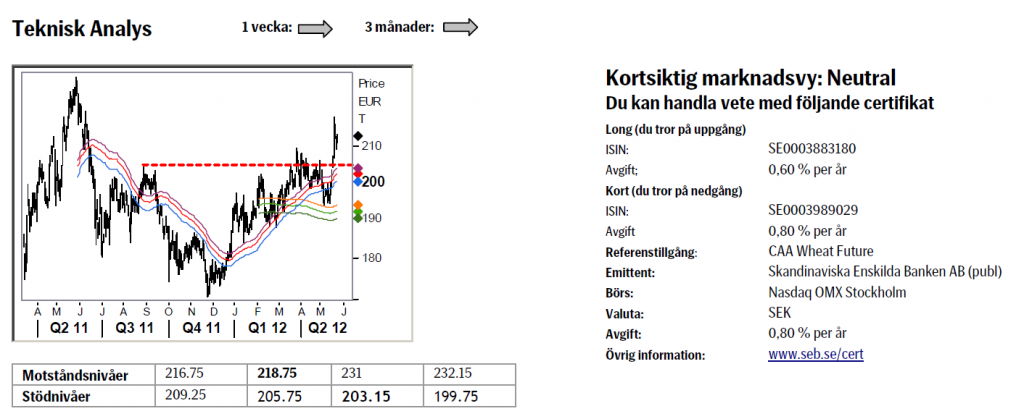Analys
SEB – Råvarukommentarer vecka 21 2012
Sammanfattning: Föregående vecka
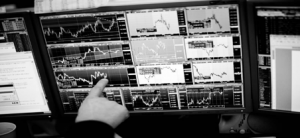 Brett råvaruindex: -1,75 %
Brett råvaruindex: -1,75 %
UBS Bloomberg CMCI TR Index- Energi: -1,12 %
UBS Bloomberg CMCI Energy TR Index - Ädelmetaller: -2,22%
UBS Bloomberg CMCI Precious Metals TR Index - Industrimetaller: -0,98 %
UBS Bloomberg CMCI Industrial Metals TR Index - Jordbruk: -3,09 %
UBS Bloomberg CMCI Agriculture TR Index
Kortsiktig marknadsvy:
- Guld: Neutral/köp
- Olja: Sälj
- Koppar: Sälj
- Majs: Sälj
- Vete: Neutral
Guld
Guldet föll 1,9 procent under veckan. För första gången på länge ser vi ett betydande utflöde ur fysiska guld ETF: er. Samtidigt kan nämnas att under samma period som guldpriset sjunkit 20 procent sedan toppen 2011 har innehaven i världens största ETF, SPDR, stigit med tre procent.
Efterfrågan på guldsmycken i Indien förväntas sjunka för tredje kvartalet i rad efter att rupien försvagats till rekordlåg nivå mot dollarn.
Greklands f.d. premiärminister Papademos sa i veckan att det finns en betydande risk för att landet kommer att lämna euro-samarbetet. EU:s ledare blir allt mer medvetna om att försöken att rädda kvar Grekland i euron håller på att misslyckas. Helst ser man att Grekland behåller euron, så den politiska viljan finns, men fortsatt stöd förutsätter att Grekland följer överenskommelser om budgetmål. Allt görs nu för att få de grekiska väljarna att förstå att de i valet den 17 juni i praktiken kommer att rösta om euromedlemskapet snarare än om fortsatta åtstramningar. Guldet har alltså fortsatt stöd av Eurozon stress.
Skolbokens gamla ”sanningen ”ökad finansiell oro – guldpriset stiger”, ter sig alltmer avlägsen.
Den starkare dollarn har också bidragit till prisfallet i guld. Euron har letat sig ned mot den svagaste nivån mot dollarn sedan sommaren 2010.
Teknisk analys: Som tidigare gäller att så länge inte C vågens botten, 1521, bryts ligger vi i startblocken för nästa uppgångsfas. Givet närheten till huvudstödet krävs en noggrannare bevakning. Dessutom anser vi att nuvarande läge är ett intressant köptillfälle för den mer spekulativt lagde. Ett köp på nuvarande nivå med en stopp loss under 1521 ger också en angenäm chans/riskprofil, om man är positiv till guldet dvs.
Olja
Oljan backade 0,29 procent och spekulativa långa positioner föll till fyra månaders lägsta. Oljan befinner sig fortfarande i en ”soft spot” pga. överproduktion (Saudiarabien försöker pressa ner oljepriset för att öka trycket på Iran) och ett negativt makrosentiment.
Chefen för International Atomic Energy Agency (IAEA) har sagt att han förväntar sig att teckna ett avtal med Iran om att få inspektera landets kärnenergianläggningar. Onsdagens möte i Bagdad där Iran och FN:s sex permanenta medlemmar i säkerhetsrådet + Tyskland möttes blev tämligen resultatlöst och resulterade främst i en sammanfattning av läget och inget nytt för framtiden. Förhoppningar fanns om en lösning på Irankonflikten efter mötet i Bagdad. Enlig API steg råoljelager med 1,5 miljoner fat och är nu på den högsta nivån sedan 1990.
Enligt onsdagens statistik från DOE steg råoljelagren med 0,8 miljoner fat.
Enligt SEB:s analytiker kommer överskottet på olja att minska redan under det tredje kvartalet i år när efterfrågan ökar säsongsmässigt.
Orkansäsongen i USA börjar nu återigen utgöra ett hot mot oljeproduktionen i Mexikanska golfen.
I USA är det långhelg och Memorial Day firas på måndag och inleder amerikanska ”driving season” vilket vanligtvis leder till en ökad efterfrågan på drivmedel. På kort sikt anser vi emellertid att mycket talar för ett fallande oljepris.
Teknisk analys: I och med brottet av 233dagars medelvärdet utlöstes en ny medelsiktig säljsignal. Sedan dess har marknaden fortsatt att falla ned till 105.15-stödet där i alla fall en mindre rekyl bör uppkomma. Väl avklarad (sälj tillfälle) ska marknaden fortsätta falla ned emot 100/101 området där nästa huvudstöd återfinnes.
Koppar
Kopparpriset föll 0,44 procent under veckan och handlade som lägst på 7500 dollar. Spekulativa långa positioner föll till ringa fem tusen kontrakt. Positiva data från amerikansk husförsäljning påverkade inte kopparpriset. Försäljningen steg till en säsongsjusterad pristakt på 343 000 enheter vilken var mer än vad analytiker räknat med.
Igår påvisade kinesiskt preliminärt inköpschefsindex för tillverkningsindustrin för maj, ett index som HSBC publicerar, en kontraktion till 48,7 från 49,3 i april. Tillverkningsindustrin gick tillbaka mot bakgrund av svagare export. Kopparn faller i takt med den europeiska krisen eftersom Europa är Kinas största handelspartner
I Kina fortsätter fastighetspriser att falla. Enligt premiärminister Wen Jiabao kommer Kina fokusera framöver på att öka fokus på tillväxt igen. Detta skulle innebära en lättad penningpolitik, något som är positivt för koppar men på kortsikt är osäkerheten stor och vi tror att priserna kan sjunka något ytterligare.
Världsbanken sänkte utsikterna för Kinas BNP till 8,2 procent 2012 från 9,2 procent 2011. Siffran är högre än Kinas egen prognos som hamnade på 7,5 procent. Landet är nu på väg mot ett sjätte kvartal med fallande tillväxt.
Kopparn har fått visst stöd av uttalande från Codelco, som bekräftade att produktionen under första kvartalet är 10 procent lägre jämfört med förra året p.g.a. låga metallhalter i malmen.
Rykten säger att JP Morgan ska lansera en ETC med fysiskt koppar som underliggande vilket skulle kunna driva upp priset. Samtidigt har vi noterat att produkter med fysiska industrimetaller (alltså inte terminskontrakt) inte varit en kommersiell framgång än så länge.
Teknisk analys: Marknaden har nu också brutit under 7885 stödet och därigenom utlöst ytterligare försäljningar. Vi kan inte se annat än att fortsatt nedgång är att vänta och att vi härnäst tar sikte på nacklinjen, 6940, på den stora huvud skuldra topp formationen.
Majs
Även jordbruksprodukterna drogs med ner av det negativa marknadssentimentet och krisen i Europa.
Majspriset föll 7,5 procent under veckan efter prognoser om nederbörd vilka gett förhoppningar om att den nyplanterade amerikanska skörden kommer att bli god. USA är världens största producent och konsument av majs.
Fokus är på väderförhållanden de närmaste veckorna och enligt Global Weather Monitoring förväntas regn i flera amerikanska delstater där man odlar majs vilket alltså är behövligt och positivt för skörden.
Enligt USDA var 77 procent av amerikansk majs i ”good or excellent condition” den 20:e maj vilket är den högsta nivån sedan 2007. Sådden i USA är nu i princip avklarad, rekordtidigt. Kortsiktigt står vi fast vid vår negativa syn men skulle torkan istället hålla i sig är det onekligen ett riskmoment.
Teknisk analys: Reaktionen från botten in kanalen renderade en mycket kraftig studs, vilken, i alla fall kortsiktigt, förhindrat det potentiella ras vi tidigare varnat för. Dock gäller även framgent att dessa kraftiga svängningar gör kortsiktiga vyer utmanande varför vi rekommenderar stor försiktighet och en mer eller mindre neutral vy.
Vete
Vi har sett stora rörelser i vetemarknaden och vetepriset föll 1,16 procent under veckan som gått.
Föregående veckas prisuppgång berodde på torrt väder i Ryssland och USA. Det är även torrt i Kina, Europa och Ukraina. Den långdragna torka som varit hotar att orsaka en sämre skörd än förväntat. Matifvetet med novemberleverans steg med tio procent på rapporterna.
Nu innehåller nya prognoser regn i USA och Europa (även om t ex Tyskland, utom de södra delarna, blir utan regn) vilket fått vetepriset att falla tillbaka. Egentligen borde risken för torka avta eftersom omfattande väderstörningar (ENSO) är neutrala och onormala väderförhållanden (La Niña- Sydostasien och Oceanien får betydligt mer nederbörd än vanligt medan delar av Sydamerika får torka) borde klinga av.
Regn förväntas nu även i Ryssland och Ukraina vilket förbättrar förutsättningarna för skörden även där.
Kvalitén för höstvetet i USA, som rapporterades i måndags, ligger på 58 procent “good /excellent” och det är två procent lägre än förra veckan. Kvalitén har alltså fallit under 60 procent “good/excellent”. Det är en nedrevidering på veckobasis men betydligt bättre än förra årets siffror.
Skörden av höstvete är nu redan klar i Louisiana, vilket är rekordtidigt. Skörden är väsentligt mindre än förväntat.
Frågan är om priset på Matif vetet kommer att falla tillbaka i spåren av mer nederbörd, eller kommer nya rapporter om torka att få priset att vända uppåt. Vi förhåller oss neutrala till vetet under kommande vecka.
Teknisk analys: Den senaste uppgången (som tog sin början ifrån strax ovanför 233dagars bandet) gick lite väl fort varför vi nu befinner oss i en kortare konsolidering. Väl avslutad, vilket vi tror att den redan kan vara, bör vi se marknaden åter stiga upp till nya toppar (och till slut också kliva upp över toppen från förra våren).
[box]SEB Veckobrev Veckans råvarukommentar är producerat av SEB Merchant Banking och publiceras i samarbete och med tillstånd på Råvarumarknaden.se[/box]
Disclaimer
The information in this document has been compiled by SEB Merchant Banking, a division within Skandinaviska Enskilda Banken AB (publ) (“SEB”).
Opinions contained in this report represent the bank’s present opinion only and are subject to change without notice. All information contained in this report has been compiled in good faith from sources believed to be reliable. However, no representation or warranty, expressed or implied, is made with respect to the completeness or accuracy of its contents and the information is not to be relied upon as authoritative. Anyone considering taking actions based upon the content of this document is urged to base his or her investment decisions upon such investigations as he or she deems necessary. This document is being provided as information only, and no specific actions are being solicited as a result of it; to the extent permitted by law, no liability whatsoever is accepted for any direct or consequential loss arising from use of this document or its contents.
About SEB
SEB is a public company incorporated in Stockholm, Sweden, with limited liability. It is a participant at major Nordic and other European Regulated Markets and Multilateral Trading Facilities (as well as some non-European equivalent markets) for trading in financial instruments, such as markets operated by NASDAQ OMX, NYSE Euronext, London Stock Exchange, Deutsche Börse, Swiss Exchanges, Turquoise and Chi-X. SEB is authorized and regulated by Finansinspektionen in Sweden; it is authorized and subject to limited regulation by the Financial Services Authority for the conduct of designated investment business in the UK, and is subject to the provisions of relevant regulators in all other jurisdictions where SEB conducts operations. SEB Merchant Banking. All rights reserved.
Analys
More weakness and lower price levels ahead, but the world won’t drown in oil in 2026

Some rebound but not much. Brent crude rebounded 1.5% yesterday to $65.47/b. This morning it is inching 0.2% up to $65.6/b. The lowest close last week was on Thursday at $64.11/b.

The curve structure is almost as week as it was before the weekend. The rebound we now have gotten post the message from OPEC+ over the weekend is to a large degree a rebound along the curve rather than much strengthening at the front-end of the curve. That part of the curve structure is almost as weak as it was last Thursday.
We are still on a weakening path. The message from OPEC+ over the weekend was we are still on a weakening path with rising supply from the group. It is just not as rapidly weakening as was feared ahead of the weekend when a quota hike of 500 kb/d/mth for November was discussed.
The Brent curve is on its way to full contango with Brent dipping into the $50ies/b. Thus the ongoing weakening we have had in the crude curve since the start of the year, and especially since early June, will continue until the Brent crude oil forward curve is in full contango along with visibly rising US and OECD oil inventories. The front-month Brent contract will then flip down towards the $60/b-line and below into the $50ies/b.
At what point will OPEC+ turn to cuts? The big question then becomes: When will OPEC+ turn around to make some cuts? At what (price) point will they choose to stabilize the market? Because for sure they will. Higher oil inventories, some more shedding of drilling rigs in US shale and Brent into the 50ies somewhere is probably where the group will step in.
There is nothing we have seen from the group so far which indicates that they will close their eyes, let the world drown in oil and the oil price crash to $40/b or below.
The message from OPEC+ is also about balance and stability. The world won’t drown in oil in 2026. The message from the group as far as we manage to interpret it is twofold: 1) Taking back market share which requires a lower price for non-OPEC+ to back off a bit, and 2) Oil market stability and balance. It is not just about 1. Thus fretting about how we are all going to drown in oil in 2026 is totally off the mark by just focusing on point 1.
When to buy cal 2026? Before Christmas when Brent hits $55/b and before OPEC+ holds its last meeting of the year which is likely to be in early December.
Brent crude oil prices have rebounded a bit along the forward curve. Not much strengthening in the structure of the curve. The front-end backwardation is not much stronger today than on its weakest level so far this year which was on Thursday last week.

The front-end backwardation fell to its weakest level so far this year on Thursday last week. A slight pickup yesterday and today, but still very close to the weakest year to date. More oil from OPEC+ in the coming months and softer demand and rising inventories. We are heading for yet softer levels.

Analys
A sharp weakening at the core of the oil market: The Dubai curve

Down to the lowest since early May. Brent crude has fallen sharply the latest four days. It closed at USD 64.11/b yesterday which is the lowest since early May. It is staging a 1.3% rebound this morning along with gains in both equities and industrial metals with an added touch of support from a softer USD on top.

What stands out the most to us this week is the collapse in the Dubai one to three months time-spread.
Dubai is medium sour crude. OPEC+ is in general medium sour crude production. Asian refineries are predominantly designed to process medium sour crude. So Dubai is the real measure of the balance between OPEC+ holding back or not versus Asian oil demand for consumption and stock building.
A sharp weakening of the front-end of the Dubai curve. The front-end of the Dubai crude curve has been holding out very solidly throughout this summer while the front-end of the Brent and WTI curves have been steadily softening. But the strength in the Dubai curve in our view was carrying the crude oil market in general. A source of strength in the crude oil market. The core of the strength.
The now finally sharp decline of the front-end of the Dubai crude curve is thus a strong shift. Weakness in the Dubai crude marker is weakness in the core of the oil market. The core which has helped to hold the oil market elevated.
Facts supports the weakening. Add in facts of Iraq lifting production from Kurdistan through Turkey. Saudi Arabia lifting production to 10 mb/d in September (normal production level) and lifting exports as well as domestic demand for oil for power for air con is fading along with summer heat. Add also in counter seasonal rise in US crude and product stocks last week. US oil stocks usually decline by 1.3 mb/week this time of year. Last week they instead rose 6.4 mb/week (+7.2 mb if including SPR). Total US commercial oil stocks are now only 2.1 mb below the 2015-19 seasonal average. US oil stocks normally decline from now to Christmas. If they instead continue to rise, then it will be strongly counter seasonal rise and will create a very strong bearish pressure on oil prices.
Will OPEC+ lift its voluntary quotas by zero, 137 kb/d, 500 kb/d or 1.5 mb/d? On Sunday of course OPEC+ will decide on how much to unwind of the remaining 1.5 mb/d of voluntary quotas for November. Will it be 137 kb/d yet again as for October? Will it be 500 kb/d as was talked about earlier this week? Or will it be a full unwind in one go of 1.5 mb/d? We think most likely now it will be at least 500 kb/d and possibly a full unwind. We discussed this in a not earlier this week: ”500 kb/d of voluntary quotas in October. But a full unwind of 1.5 mb/d”
The strength in the front-end of the Dubai curve held out through summer while Brent and WTI curve structures weakened steadily. That core strength helped to keep flat crude oil prices elevated close to the 70-line. Now also the Dubai curve has given in.

Brent crude oil forward curves

Total US commercial stocks now close to normal. Counter seasonal rise last week. Rest of year?

Total US crude and product stocks on a steady trend higher.

Analys
OPEC+ will likely unwind 500 kb/d of voluntary quotas in October. But a full unwind of 1.5 mb/d in one go could be in the cards

Down to mid-60ies as Iraq lifts production while Saudi may be tired of voluntary cut frugality. The Brent December contract dropped 1.6% yesterday to USD 66.03/b. This morning it is down another 0.3% to USD 65.8/b. The drop in the price came on the back of the combined news that Iraq has resumed 190 kb/d of production in Kurdistan with exports through Turkey while OPEC+ delegates send signals that the group will unwind the remaining 1.65 mb/d (less the 137 kb/d in October) of voluntary cuts at a pace of 500 kb/d per month pace.

Signals of accelerated unwind and Iraqi increase may be connected. Russia, Kazakhstan and Iraq were main offenders versus the voluntary quotas they had agreed to follow. Russia had a production ’debt’ (cumulative overproduction versus quota) of close to 90 mb in March this year while Kazakhstan had a ’debt’ of about 60 mb and the same for Iraq. This apparently made Saudi Arabia angry this spring. Why should Saudi Arabia hold back if the other voluntary cutters were just freeriding? Thus the sudden rapid unwinding of voluntary cuts. That is at least one angle of explanations for the accelerated unwinding.
If the offenders with production debts then refrained from lifting production as the voluntary cuts were rapidly unwinded, then they could ’pay back’ their ’debts’ as they would under-produce versus the new and steadily higher quotas.
Forget about Kazakhstan. Its production was just too far above the quotas with no hope that the country would hold back production due to cross-ownership of oil assets by international oil companies. But Russia and Iraq should be able to do it.
Iraqi cumulative overproduction versus quotas could reach 85-90 mb in October. Iraq has however steadily continued to overproduce by 3-5 mb per month. In July its new and gradually higher quota came close to equal with a cumulative overproduction of only 0.6 mb that month. In August again however its production had an overshoot of 100 kb/d or 3.1 mb for the month. Its cumulative production debt had then risen to close to 80 mb. We don’t know for September yet. But looking at October we now know that its production will likely average close to 4.5 mb/d due to the revival of 190 kb/d of production in Kurdistan. Its quota however will only be 4.24 mb/d. Its overproduction in October will thus likely be around 250 kb/d above its quota with its production debt rising another 7-8 mb to a total of close to 90 mb.
Again, why should Saudi Arabia be frugal while Iraq is freeriding. Better to get rid of the voluntary quotas as quickly as possible and then start all over with clean sheets.
Unwinding the remaining 1.513 mb/d in one go in October? If OPEC+ unwinds the remaining 1.513 mb/d of voluntary cuts in one big go in October, then Iraq’s quota will be around 4.4 mb/d for October versus its likely production of close to 4.5 mb/d for the coming month..
OPEC+ should thus unwind the remaining 1.513 mb/d (1.65 – 0.137 mb/d) in one go for October in order for the quota of Iraq to be able to keep track with Iraq’s actual production increase.
October 5 will show how it plays out. But a quota unwind of at least 500 kb/d for Oct seems likely. An overall increase of at least 500 kb/d in the voluntary quota for October looks likely. But it could be the whole 1.513 mb/d in one go. If the increase in the quota is ’only’ 500 kb/d then Iraqi cumulative production will still rise by 5.7 mb to a total of 85 mb in October.
Iraqi production debt versus quotas will likely rise by 5.7 mb in October if OPEC+ only lifts the overall quota by 500 kb/d in October. Here assuming historical production debt did not rise in September. That Iraq lifts its production by 190 kb/d in October to 4.47 mb/d (August level + 190 kb/d) and that OPEC+ unwinds 500 kb/d of the remining quotas in October when they decide on this on 5 October.

-

 Nyheter4 veckor sedan
Nyheter4 veckor sedanMahvie Minerals i en guldtrend
-

 Analys4 veckor sedan
Analys4 veckor sedanVolatile but going nowhere. Brent crude circles USD 66 as market weighs surplus vs risk
-

 Nyheter4 veckor sedan
Nyheter4 veckor sedanAktier i guldbolag laggar priset på guld
-

 Nyheter3 veckor sedan
Nyheter3 veckor sedanKinas elproduktion slog nytt rekord i augusti, vilket även kolkraft gjorde
-

 Nyheter3 veckor sedan
Nyheter3 veckor sedanTyskland har så höga elpriser att företag inte har råd att använda elektricitet
-

 Nyheter4 veckor sedan
Nyheter4 veckor sedanGuld når sin högsta nivå någonsin, nu även justerat för inflation
-

 Nyheter4 veckor sedan
Nyheter4 veckor sedanDet stigande guldpriset en utmaning för smyckesköpare
-

 Analys4 veckor sedan
Analys4 veckor sedanWaiting for the surplus while we worry about Israel and Qatar


